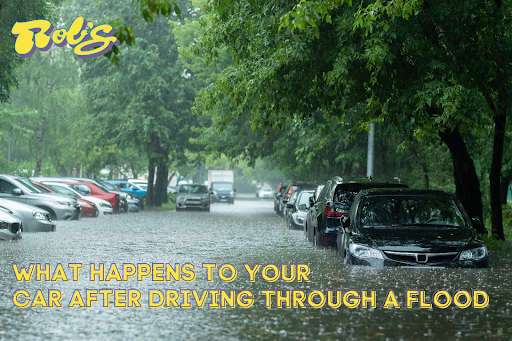What Happens to Your Car After Driving Through a Flood
September 22, 2021


You should always try to avoid driving through a flood. Although it might seem possible to forge through a submerged area with your vehicle, a flooded car can sustain costly and dangerous damage — sometimes, even more so than an automotive collision. It can be easy to underestimate how deep the water is until your car is already submerged, so be mindful when driving during heavy rain.
At Rob’s Automotive, our trained technicians have the expertise and resources to provide repair services for all flood-related automotive issues. If you’ve been lucky enough not to have your car stall out while submerged, yet are now experiencing problems due to driving through high water, make sure to contact us right away!
Below are five types of damage your vehicle can suffer after driving in a flood.
Engine Damage
Driving in a flood can create disastrous problems for your car’s engine, even if the water levels aren’t particularly deep. Engines need fresh air to create combustion; if flood water enters the cylinders, it will cause the pistons to stop. This scenario is called hydro locking, which stalls the vehicle and prevents it from moving.
The piston rods can also bend and break off, making for a costly fix. A hydro-locked engine may need to be replaced entirely, so think twice before driving in a flood. This can occur in water that doesn’t appear to be deep as the intake is usually located in the front bumper of a newer vehicle.
Wet Brakes
Brakes can reach incredibly high temperatures, but the presence of water will cause them to warp because of the immense amount of heat they can generate. As a result of this warping, they can lose their grip, making it more difficult to stop. Additionally, wet brakes can generate strange noises and vibrations.
Harmed Electronics
Unsurprisingly, electronics will sustain heavy damage in a flooded car. Some wires and fuse boxes are water-resistant and well protected, but the consequences are as severe as they are expensive if these critical parts are harmed.
Furthermore, many components of vehicles contain electronic devices, such as headlights, heated seats, windshield wipers, and more. If they are damaged by water, then they could stop working; this is especially problematic if the vehicle’s vital functions, such as the transmission or brakes, are short-circuited.
Transmission Issues
Another way that driving in a flood can hurt your vehicle is by messing up its transmission. If water ever enters the vent of the transmission, it can create problems by disrupting the lubricant and breaking the lining of the transmission. Water can also cause the gears to slip or even contaminate the transmission oil, meaning there are many ways a flooded car’s transmission can fail and stop working.
Interior Damage
Although the inside of your car isn’t directly related to its mechanical capabilities, the interior furnishings of a flooded vehicle are also highly susceptible to damage. The floors and seating of the vehicle will soak up the unsanitary and filthy water from the flash flood, leading to mold growth if you don’t dry out the moisture quickly enough. Additionally, the dirty interior will start to smell awful from the bacteria, which will damage the air quality for the driver and their passengers.
Flood Damage Repair for Vehicles: Is It Possible?
Any vehicle that has been exposed to high water needs to be inspected by a trained professional for potential damages. Electrical, mechanical, and even cosmetic components are highly susceptible to water damage.
Rob’s Automotive is your source for comprehensive post-flood evaluations of your vehicle. Being certified by over 14 major car manufacturers, our team can thoroughly inspect any type of vehicle to check for water damage. If your car isn’t operable, we offer tow truck services for Philadelphia, PA, and the surrounding areas to bring your vehicle directly to our shop for repairs.
Contact us today to learn more about Rob’s Automotive or to schedule an appointment!
